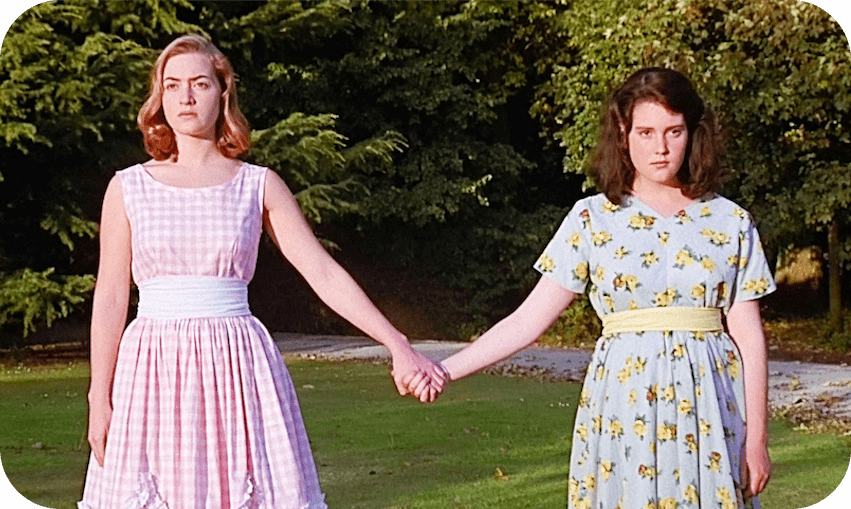Alex Casey returns to a New Zealand classic on its 30th birthday.
Just yesterday I walked a track through Christchurch’s Victoria Park and boy was it pleasant. The sunlight beamed through the canopy of trees, providing welcome warm zones in the cool forest air. Everyone grinned goofily as they passed each other, and peppy pīwakawaka chirped and flitted about. But as my dog stopped to happily chew on a pinecone, I couldn’t help but wonder something much darker – how close were we to the Heavenly Creatures spot?
As it turns out, the location used in Peter Jackson’s 1994 film isn’t actually the real place where teenagers Pauline Parker and Juliet Hulme committed the murder of Honora Parker 40 years prior. “We knew that there was no way that we could recreate the murder on the spot where it happened,” Jackson told The Press. “It was enough that we were recreating the murder on film: To do that in the place where it had really happened would have been going too far.”
This is just one of many sensitivities Jackson would have had to deal with when he boldly decided to make a film about one of the most bizarre and notorious murders in New Zealand history. Released 30 years ago today, Heavenly Creatures launched the careers of Melanie Lynskey and Kate Winslet, received an Oscar nomination among many other awards, and propelled Peter Jackson from sicko splatter king to a mainstream critical darling.
I sat down and rewatched Heavenly Creatures that evening after my walk through Victoria Park, and was reminded yet again of what an ambitious, bizarre, beautiful and brutal film it is. Opening with technicolor archival footage of blossoming 1950s Christchurch, the “gay and colourful” garden scenes are soon intercut with Winslet and Lynskey running through Victoria Park and screaming, blood splattered all over their faces.
Given his history up until that point of chopping people up with lawnmowers and pulverising heads in blenders, Jackson could have made a very different movie about the horrors of the Parker-Hulme murder. Instead of being entirely about the crime itself, the focus of Heavenly Creatures is almost entirely on the relationship between the two girls, and how they built themselves an entire fantasy universe that had unimaginable repercussions in the real world.
That is not to say that the splatter flourishes aren’t still there. Aside from the obvious climax scene in which one might naturally deploy lashings of blood, Jackson uses Pauline and Juliet’s fantasy universe as a chance to play with fantasy violence. The clay characters that populate their imagined world of Borovnia are sliced in half, decapitated and stabbed through the front, in deftly bloodless action sequences that feel like a rehearsal for The Lord of the Rings.
Speaking of Lord of the Rings, it’s also interesting to see how some of Jackson’s visual language carried over into his opus just a few years later. I don’t know the technical lingo here, but the man absolutely loves a swoopy shot that ends right on the character’s face to punctuate an important line of dialogue. When we are transported to the towering castles of Borovnia, rendered from miniature models, it’s hard not to see Helm’s Deep from The Two Towers.
What’s also remarkable to behold are the performances from Lynskey and Winslet, both in their debut film roles. Lynskey’s wallflower Pauline (or Paul, or Yvonne, or Gina, depending who is addressing her in the film) has the best glower ever committed to the silver screen, her unruly nest of hair working to illustrate the chaotic, prickly imagination lurking beneath. Winslet’s Juliet is the total opposite – controlled, charismatic, captivating.
Together, the pair feed off each other in a frenzy of teenage feelings that feel as relevant now as they did in 1954. They are misunderstood by their parents, their teachers and the world. They want to keep playing like little kids, while also dreaming of adult romance and sordid affairs. They are trapped in a time with extremely rigid ideas about what a difficult woman is, calling to mind this year’s fantastic We Were Dangerous as a spiritual companion of sorts.
As the girls start to build their imaginary world, the film blossoms with giant CGI butterflies, pastel sundresses and unicorns. It feels like Sophia Coppola meets Amelie meets Tumblr type aesthetic, but nearly two decades earlier. Also way ahead of the curve is the way the film fearlessly explores the girls’ growing romantic relationship (which Hulme has categorically denied existing, stating back in 2007 that the relationship was simply “obsessive”.)
Three decades on, the impact of Heavenly Creatures is everywhere. As someone who spends a fair bit of time talking to creative people about their influences, it’s never far from the conversation. “God, everything about that movie made an impact on me,” Tom Sainsbury said during an interview about making his own nature walk horror Loop Track. “So much of the fantasy world was glorious, but then it was also so brutal and fantastic and horrifying.”
Anika Moa also mentioned Heavenly Creatures in the middle of our My Life in TV interview, after revealing that Kate Winslet was her first onscreen crush. “I studied that movie so much and rewound and learned every single line,” she said back in 2022. “I just think that i’s the best movie in the world.” Both Lynskey and Winslet, who obviously both went on to have tremendous careers, can often be found referring back to the film that started it all.
And as for Peter Jackson? We all know what happened next. He returned to Christchurch to make The Frighteners with Michael J. Fox in 1996, before embarking on the trilogy that would win 17 Academy Awards, make $3 billion in the global box office, and singlehandedly transform the screen and tourism industry in Aotearoa. Achievements and accolades galore, sure, but it is Heavenly Creatures that still quietly feels like Jackson’s true masterpiece.



